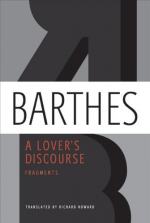
|
| Name: _________________________ | Period: ___________________ |
This test consists of 15 multiple choice questions and 5 short answer questions.
Multiple Choice Questions
1. In Love's Obscenity/Obscene, what is the author's first example of obscenity?
(a) A poem by Sappho.
(b) Each occasion in the text that the word "love" is used.
(c) A Japanese haiku about love.
(d) Werther's obvious love for Charlotte.
2. What is another name used in The Ribbon/Objects to describe the lover's attachment to an object that belonged to the beloved?
(a) Fanaticism.
(b) Nostalgia.
(c) Mania.
(d) Fetishism.
3. What does the lover acknowledge in This can't go on/Unbearable?
(a) The Unknowable.
(b) The sacrifices the other has made.
(c) The end of desire.
(d) The Unbearable.
4. In "Dedication," the author presents an internal dialogue that accompanies which of the following acts?
(a) The dedication of one's life to a cause.
(b) The act of giving a gift, or some other form of dedication, to the object of love.
(c) Making a formal commitment to the other.
(d) Receiving a gift from the other.
5. How does Werther fall in love with Charlotte in the section "Show me whom to desire/Induction?"
(a) He falls for her without ever seeing or hearing about her before.
(b) Her beauty is pointed out to him before he sees her, then he falls for her.
(c) At first he dislikes her then he changes his mind.
(d) He meets her at a friend's wedding and is smitten.
6. In "I am odious"/Monstrous, what does the lover's discourse do to the other?
(a) It drives him to suicide.
(b) It causes him to reply in kind.
(c) It stifles him, imposing silence.
(d) It irritates him.
7. Which relationship dynamic does the section of the text entitled "Domnei" or "dependency" describe?
(a) The couple decides to discuss problems of dependency.
(b) The amorous subject is subjugated to the loved object.
(c) The loved object is much too dependent on the amorous subject.
(d) Common belief always places the woman in the submissive role.
8. What causes the particular feeling, experienced by the character Werther, in the episode involving oranges?
(a) The object of desire rejects his offering of oranges.
(b) The object of desire receives his gift and refuses to share it.
(c) The object of desire shares the oranges he gave her with a neighbor.
(d) The object of desire is oblivious to his gift.
9. What does the lover give the other when he offers a gift?
(a) A souvenir of happier times.
(b) Something useless and impractical.
(c) An expensive token of affection.
(d) Something he has touched and invested with emotion.
10. Where does the name Gradiva derive from?
(a) A goddess from classical Greek mythology.
(b) A play about a 19th-century society woman.
(c) A book in which the delirious hero mistakes an image for the actual woman he loves.
(d) One of Sigmund Freud's female patients.
11. "In the loving calm of your arms" describes the embrace of total union between lovers. What contradiction does the lover experience?
(a) The lover feels both male and female.
(b) The lover is neither completely awake or asleep.
(c) The lover is both mother and father.
(d) The lover is both child and adult.
12. In Blue Coat and Yellow Vest/habiliment, what specifically does the "blue coat and yellow vest" refer to?
(a) To clothing worn by the other that becomes a fetish object.
(b) To the narrator's favorite outfit.
(c) To clothing worn by the character Werther.
(d) To the costume of travelers.
13. What kind of acts does the lover perform in The Last Leaf/Magic.
(a) Magic consultations, secret rites, and votive actions.
(b) Acts of selfless love.
(c) Acts of infidelity.
(d) Meditations, contemplations, and silences.
14. Which of the following phrases describes the informer in the section called The Informer?
(a) A malicious gossip.
(b) A friendly figure who wounds the subject.
(c) An enemy who tries to destroy the subject.
(d) A rival.
15. Match the term "loquela" with the correct phrase.
(a) "I keep swallowing and regurgitating my wound."
(b) "I know that you know that I know."
(c) "I doom myself to blackmail."
(d) "I fall in love again and again."
Short Answer Questions
1. How does the informer wound the subject?
2. What is the dual nature of the figure of Gradiva?
3. What does the young Freud say to his fiancée in The Love Letter?
4. Which of the following scenarios is described in No Answer/Silence?
5. What image does the author evoke to represent the "exuberance" that results from constantly expending love?
|
This section contains 805 words (approx. 3 pages at 300 words per page) |

|




